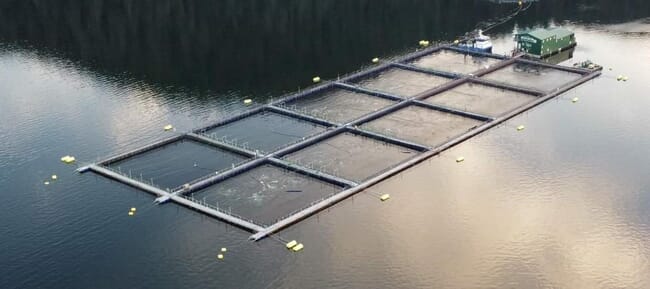
Before government-directed shutdowns since 2020, the BC salmon farming sector employed approximately 6,500 people, produced close to 500 million salmon meals per year and had an economic value of $2 billion. Shutdowns since 2020 reduced supply by 40 percent, increasing the carbon footprint of imported salmon to North America by the equivalent of adding over 50,000 cars to the road. © BCSFA
According to the Canadian Aquaculture Industry Alliance (CAIA), eco-activist group Wild First stated on the billboards that “Open-net pen salmon farms are banned in Washington, Oregon, California, and Alaska” and called on Ottawa to “remove all salmon farms from BC waters.”
However, CAIA responded with a letter explaining that farming finfish (including salmon) is not banned in California, Oregon or Washington and that, in Alaska, net pens are commonly used to raise salmon for commercial purposes.
“In an age of misinformation, we are pleased that the right thing happened – false ads that did not stand up to the truth test were removed,” said Tim Kennedy, CAIA president and CEO, in a press release.
“Activists with deep pockets who don’t live or work where our salmon farmers live and work are trying to drive policy decisions in Ottawa that would cancel people’s livelihoods using a storyline based on old data and false information.”
“These anti-salmon billboards included statements by the activist group Wild First that were both false and potentially economically harmful to British Columbia businesses and organizations and their employees that the Canadian Aquaculture Industry Alliance represents. Modern, sustainable, in-ocean salmon aquaculture is the second biggest agri-food export in British Columbia and key to the blue economy future for people living in rural, coastal and Indigenous communities.”
Why the claims were false
The billboard agency was given clear evidence showing state regulations in California allow persons to lease water bottoms or the water column for the purposes of aquaculture including marine finfish farming. In Washington state, where aquaculture has been encouraged since the passage of the Aquaculture Act in 1985, the farming of native fish species in the marine environment (net pens) is allowed and despite political rhetoric by anti-net pen groups in Washington, there is no net pen ban or moratorium. No regulations in any of the four states ban the use of netting (net pens) for the purpose of containing fish.
“In Alaska, the use of net pens is common practice in their salmon aquaculture programs,” added Kennedy. Detailed in the Alaska Department Fish and Game’s Salmon Fisheries Enhancement Report, the state’s aquaculture program grew approximately 1.9 billion juvenile salmon in a combination of land-based hatcheries and ocean-based net pens in 2022. Approximately 43 million aquaculture-raised salmon returned as adults that same year to be captured within the commercial and sport fishery.
One example evidenced by CAIA is the Northern Southeast Regional Aquaculture Association. The association collects salmon eggs late summer that are incubated through the fall and winter, then put into marine pens in late winter or early spring. The fry (young fish) are reared in marine net pens for approximately five months before being released into the wild in late spring to supply the commercial fishing industry and sport angling sector.




